Construction 3D Printing: A Comprehensive Analysis of Technologies
VerifiedAdded on 2023/04/20
|24
|6710
|160
Report
AI Summary
This report provides a comprehensive overview of 3D printing in the construction industry, starting with an introduction to 3D printing technology and its various processes such as Stereolithography (SLA), Selective Laser Sintering (SLS), Fused Deposition Modelling (FDM), and Inkjet Powder Printing. It delves into specific construction 3D printing technologies like Contour Crafting, D-Shape, Concrete Printing, and CONPrint3D, highlighting their mechanisms and advantages. The report also discusses the advantages and disadvantages of construction 3D printing, the performance of 3D printed concrete, and the technology's impact on sustainability, employment, logistics, and cost. It further addresses the issues affecting the implementation of 3D printing in construction, explores suitable and current applications, and forecasts future applications, providing a holistic view of the transformative potential of 3D printing in the construction sector. Desklib provides access to solved assignments and past papers for students.

Construction 3D Printing 1
CONSTRUCTION 3D PRINTING
Name
Course
Professor
University
City/state
Date
CONSTRUCTION 3D PRINTING
Name
Course
Professor
University
City/state
Date
Paraphrase This Document
Need a fresh take? Get an instant paraphrase of this document with our AI Paraphraser
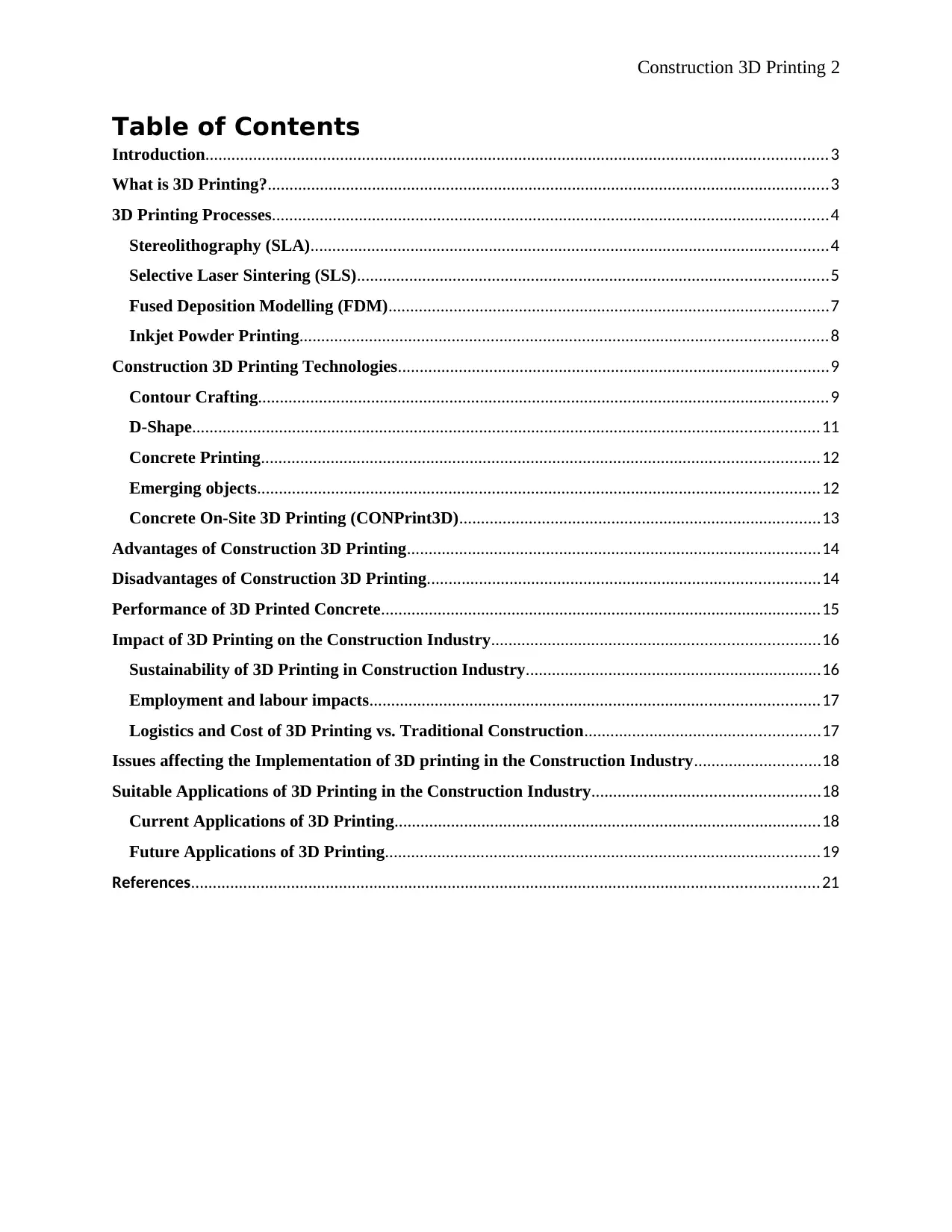
Construction 3D Printing 2
Table of Contents
Introduction...............................................................................................................................................3
What is 3D Printing?.................................................................................................................................3
3D Printing Processes................................................................................................................................4
Stereolithography (SLA).......................................................................................................................4
Selective Laser Sintering (SLS)............................................................................................................5
Fused Deposition Modelling (FDM).....................................................................................................7
Inkjet Powder Printing.........................................................................................................................8
Construction 3D Printing Technologies...................................................................................................9
Contour Crafting...................................................................................................................................9
D-Shape................................................................................................................................................11
Concrete Printing................................................................................................................................12
Emerging objects.................................................................................................................................12
Concrete On-Site 3D Printing (CONPrint3D)...................................................................................13
Advantages of Construction 3D Printing...............................................................................................14
Disadvantages of Construction 3D Printing..........................................................................................14
Performance of 3D Printed Concrete.....................................................................................................15
Impact of 3D Printing on the Construction Industry...........................................................................16
Sustainability of 3D Printing in Construction Industry....................................................................16
Employment and labour impacts.......................................................................................................17
Logistics and Cost of 3D Printing vs. Traditional Construction......................................................17
Issues affecting the Implementation of 3D printing in the Construction Industry.............................18
Suitable Applications of 3D Printing in the Construction Industry....................................................18
Current Applications of 3D Printing..................................................................................................18
Future Applications of 3D Printing....................................................................................................19
References................................................................................................................................................21
Table of Contents
Introduction...............................................................................................................................................3
What is 3D Printing?.................................................................................................................................3
3D Printing Processes................................................................................................................................4
Stereolithography (SLA).......................................................................................................................4
Selective Laser Sintering (SLS)............................................................................................................5
Fused Deposition Modelling (FDM).....................................................................................................7
Inkjet Powder Printing.........................................................................................................................8
Construction 3D Printing Technologies...................................................................................................9
Contour Crafting...................................................................................................................................9
D-Shape................................................................................................................................................11
Concrete Printing................................................................................................................................12
Emerging objects.................................................................................................................................12
Concrete On-Site 3D Printing (CONPrint3D)...................................................................................13
Advantages of Construction 3D Printing...............................................................................................14
Disadvantages of Construction 3D Printing..........................................................................................14
Performance of 3D Printed Concrete.....................................................................................................15
Impact of 3D Printing on the Construction Industry...........................................................................16
Sustainability of 3D Printing in Construction Industry....................................................................16
Employment and labour impacts.......................................................................................................17
Logistics and Cost of 3D Printing vs. Traditional Construction......................................................17
Issues affecting the Implementation of 3D printing in the Construction Industry.............................18
Suitable Applications of 3D Printing in the Construction Industry....................................................18
Current Applications of 3D Printing..................................................................................................18
Future Applications of 3D Printing....................................................................................................19
References................................................................................................................................................21
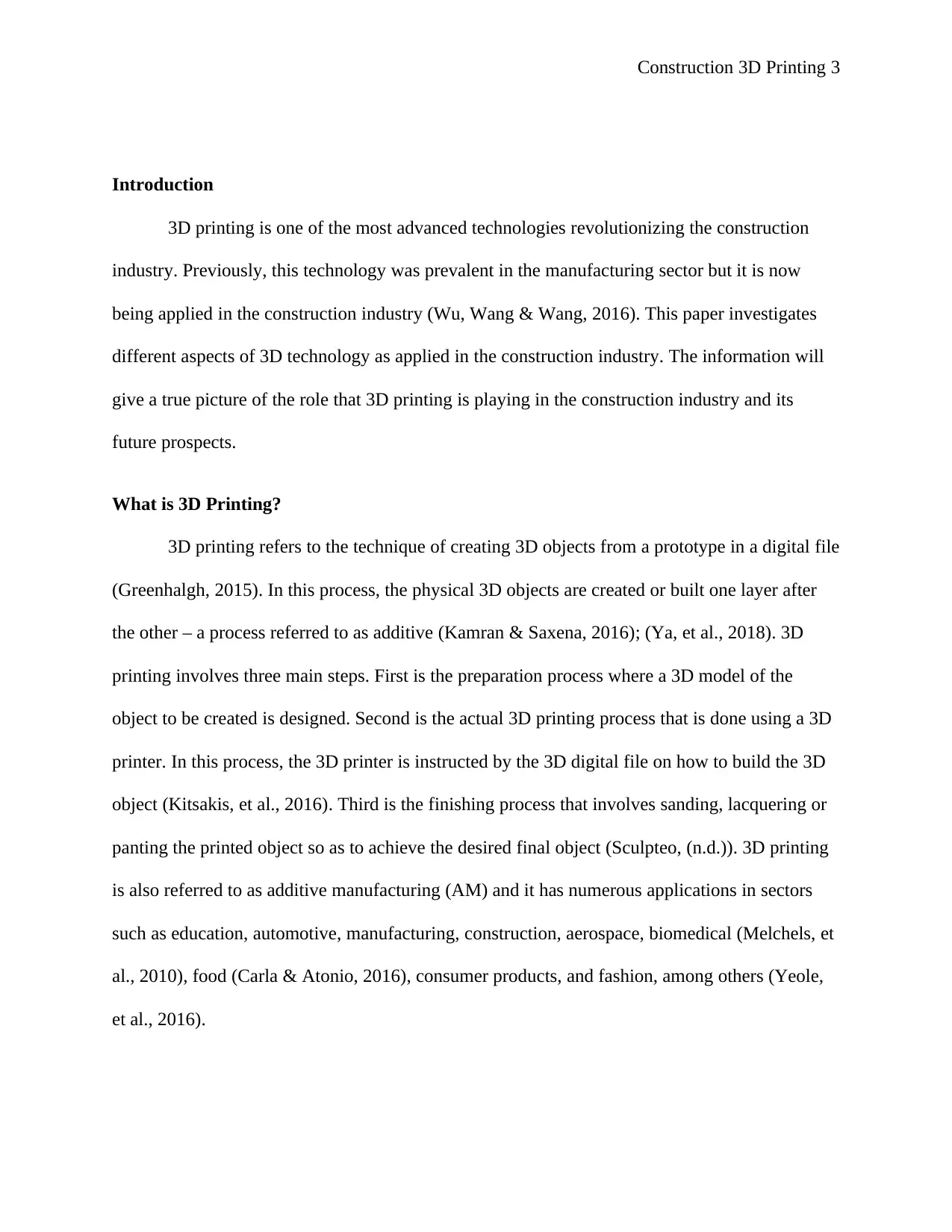
Construction 3D Printing 3
Introduction
3D printing is one of the most advanced technologies revolutionizing the construction
industry. Previously, this technology was prevalent in the manufacturing sector but it is now
being applied in the construction industry (Wu, Wang & Wang, 2016). This paper investigates
different aspects of 3D technology as applied in the construction industry. The information will
give a true picture of the role that 3D printing is playing in the construction industry and its
future prospects.
What is 3D Printing?
3D printing refers to the technique of creating 3D objects from a prototype in a digital file
(Greenhalgh, 2015). In this process, the physical 3D objects are created or built one layer after
the other – a process referred to as additive (Kamran & Saxena, 2016); (Ya, et al., 2018). 3D
printing involves three main steps. First is the preparation process where a 3D model of the
object to be created is designed. Second is the actual 3D printing process that is done using a 3D
printer. In this process, the 3D printer is instructed by the 3D digital file on how to build the 3D
object (Kitsakis, et al., 2016). Third is the finishing process that involves sanding, lacquering or
panting the printed object so as to achieve the desired final object (Sculpteo, (n.d.)). 3D printing
is also referred to as additive manufacturing (AM) and it has numerous applications in sectors
such as education, automotive, manufacturing, construction, aerospace, biomedical (Melchels, et
al., 2010), food (Carla & Atonio, 2016), consumer products, and fashion, among others (Yeole,
et al., 2016).
Introduction
3D printing is one of the most advanced technologies revolutionizing the construction
industry. Previously, this technology was prevalent in the manufacturing sector but it is now
being applied in the construction industry (Wu, Wang & Wang, 2016). This paper investigates
different aspects of 3D technology as applied in the construction industry. The information will
give a true picture of the role that 3D printing is playing in the construction industry and its
future prospects.
What is 3D Printing?
3D printing refers to the technique of creating 3D objects from a prototype in a digital file
(Greenhalgh, 2015). In this process, the physical 3D objects are created or built one layer after
the other – a process referred to as additive (Kamran & Saxena, 2016); (Ya, et al., 2018). 3D
printing involves three main steps. First is the preparation process where a 3D model of the
object to be created is designed. Second is the actual 3D printing process that is done using a 3D
printer. In this process, the 3D printer is instructed by the 3D digital file on how to build the 3D
object (Kitsakis, et al., 2016). Third is the finishing process that involves sanding, lacquering or
panting the printed object so as to achieve the desired final object (Sculpteo, (n.d.)). 3D printing
is also referred to as additive manufacturing (AM) and it has numerous applications in sectors
such as education, automotive, manufacturing, construction, aerospace, biomedical (Melchels, et
al., 2010), food (Carla & Atonio, 2016), consumer products, and fashion, among others (Yeole,
et al., 2016).
⊘ This is a preview!⊘
Do you want full access?
Subscribe today to unlock all pages.

Trusted by 1+ million students worldwide
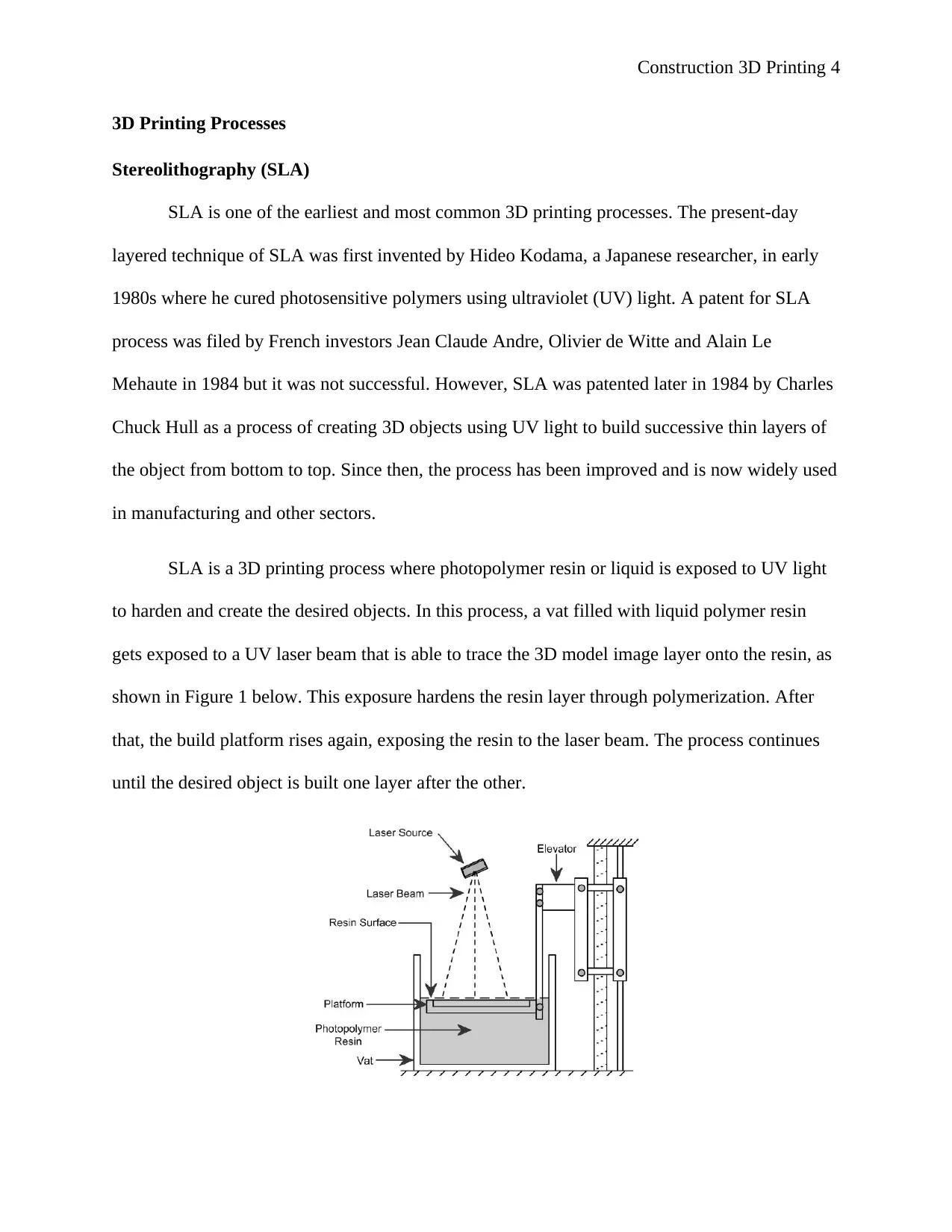
Construction 3D Printing 4
3D Printing Processes
Stereolithography (SLA)
SLA is one of the earliest and most common 3D printing processes. The present-day
layered technique of SLA was first invented by Hideo Kodama, a Japanese researcher, in early
1980s where he cured photosensitive polymers using ultraviolet (UV) light. A patent for SLA
process was filed by French investors Jean Claude Andre, Olivier de Witte and Alain Le
Mehaute in 1984 but it was not successful. However, SLA was patented later in 1984 by Charles
Chuck Hull as a process of creating 3D objects using UV light to build successive thin layers of
the object from bottom to top. Since then, the process has been improved and is now widely used
in manufacturing and other sectors.
SLA is a 3D printing process where photopolymer resin or liquid is exposed to UV light
to harden and create the desired objects. In this process, a vat filled with liquid polymer resin
gets exposed to a UV laser beam that is able to trace the 3D model image layer onto the resin, as
shown in Figure 1 below. This exposure hardens the resin layer through polymerization. After
that, the build platform rises again, exposing the resin to the laser beam. The process continues
until the desired object is built one layer after the other.
3D Printing Processes
Stereolithography (SLA)
SLA is one of the earliest and most common 3D printing processes. The present-day
layered technique of SLA was first invented by Hideo Kodama, a Japanese researcher, in early
1980s where he cured photosensitive polymers using ultraviolet (UV) light. A patent for SLA
process was filed by French investors Jean Claude Andre, Olivier de Witte and Alain Le
Mehaute in 1984 but it was not successful. However, SLA was patented later in 1984 by Charles
Chuck Hull as a process of creating 3D objects using UV light to build successive thin layers of
the object from bottom to top. Since then, the process has been improved and is now widely used
in manufacturing and other sectors.
SLA is a 3D printing process where photopolymer resin or liquid is exposed to UV light
to harden and create the desired objects. In this process, a vat filled with liquid polymer resin
gets exposed to a UV laser beam that is able to trace the 3D model image layer onto the resin, as
shown in Figure 1 below. This exposure hardens the resin layer through polymerization. After
that, the build platform rises again, exposing the resin to the laser beam. The process continues
until the desired object is built one layer after the other.
Paraphrase This Document
Need a fresh take? Get an instant paraphrase of this document with our AI Paraphraser
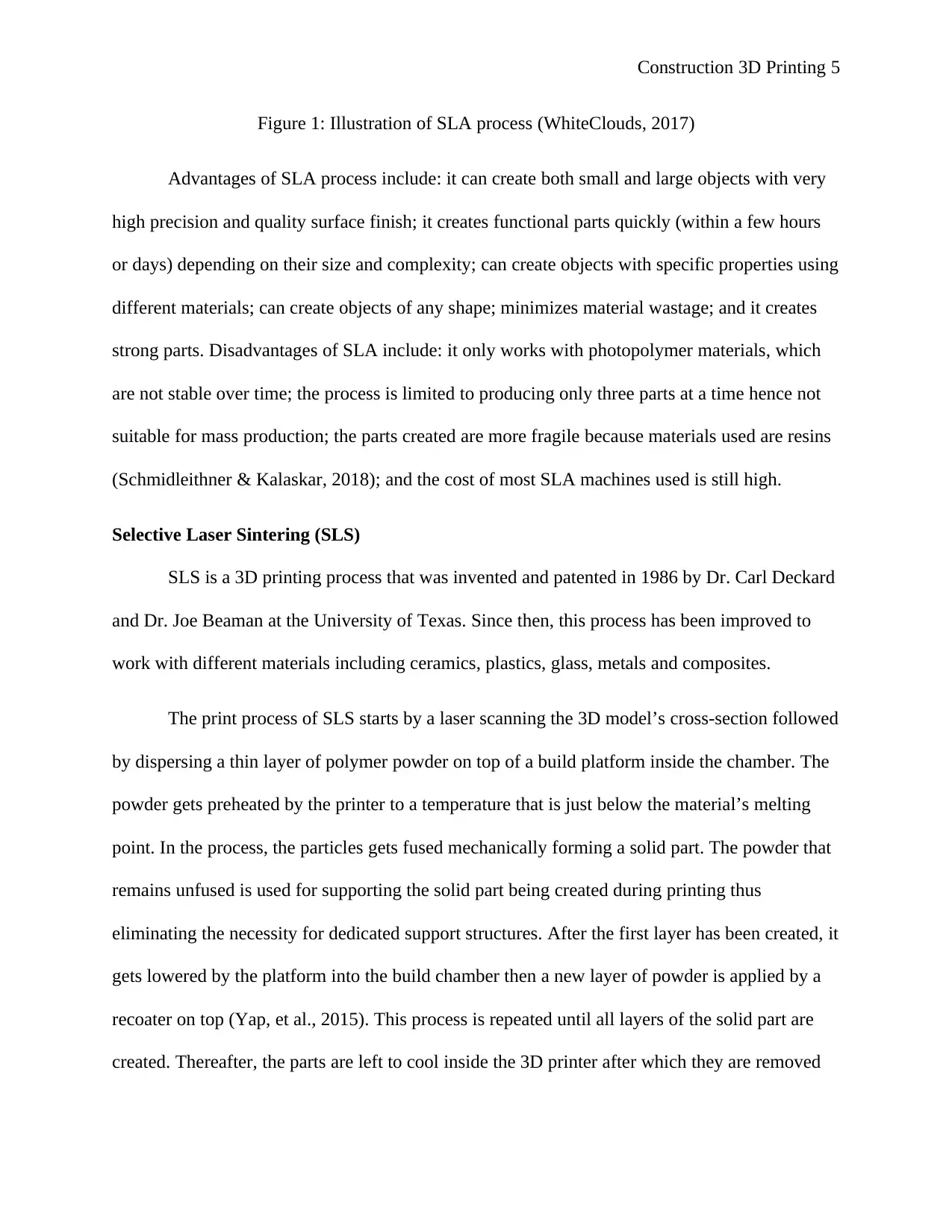
Construction 3D Printing 5
Figure 1: Illustration of SLA process (WhiteClouds, 2017)
Advantages of SLA process include: it can create both small and large objects with very
high precision and quality surface finish; it creates functional parts quickly (within a few hours
or days) depending on their size and complexity; can create objects with specific properties using
different materials; can create objects of any shape; minimizes material wastage; and it creates
strong parts. Disadvantages of SLA include: it only works with photopolymer materials, which
are not stable over time; the process is limited to producing only three parts at a time hence not
suitable for mass production; the parts created are more fragile because materials used are resins
(Schmidleithner & Kalaskar, 2018); and the cost of most SLA machines used is still high.
Selective Laser Sintering (SLS)
SLS is a 3D printing process that was invented and patented in 1986 by Dr. Carl Deckard
and Dr. Joe Beaman at the University of Texas. Since then, this process has been improved to
work with different materials including ceramics, plastics, glass, metals and composites.
The print process of SLS starts by a laser scanning the 3D model’s cross-section followed
by dispersing a thin layer of polymer powder on top of a build platform inside the chamber. The
powder gets preheated by the printer to a temperature that is just below the material’s melting
point. In the process, the particles gets fused mechanically forming a solid part. The powder that
remains unfused is used for supporting the solid part being created during printing thus
eliminating the necessity for dedicated support structures. After the first layer has been created, it
gets lowered by the platform into the build chamber then a new layer of powder is applied by a
recoater on top (Yap, et al., 2015). This process is repeated until all layers of the solid part are
created. Thereafter, the parts are left to cool inside the 3D printer after which they are removed
Figure 1: Illustration of SLA process (WhiteClouds, 2017)
Advantages of SLA process include: it can create both small and large objects with very
high precision and quality surface finish; it creates functional parts quickly (within a few hours
or days) depending on their size and complexity; can create objects with specific properties using
different materials; can create objects of any shape; minimizes material wastage; and it creates
strong parts. Disadvantages of SLA include: it only works with photopolymer materials, which
are not stable over time; the process is limited to producing only three parts at a time hence not
suitable for mass production; the parts created are more fragile because materials used are resins
(Schmidleithner & Kalaskar, 2018); and the cost of most SLA machines used is still high.
Selective Laser Sintering (SLS)
SLS is a 3D printing process that was invented and patented in 1986 by Dr. Carl Deckard
and Dr. Joe Beaman at the University of Texas. Since then, this process has been improved to
work with different materials including ceramics, plastics, glass, metals and composites.
The print process of SLS starts by a laser scanning the 3D model’s cross-section followed
by dispersing a thin layer of polymer powder on top of a build platform inside the chamber. The
powder gets preheated by the printer to a temperature that is just below the material’s melting
point. In the process, the particles gets fused mechanically forming a solid part. The powder that
remains unfused is used for supporting the solid part being created during printing thus
eliminating the necessity for dedicated support structures. After the first layer has been created, it
gets lowered by the platform into the build chamber then a new layer of powder is applied by a
recoater on top (Yap, et al., 2015). This process is repeated until all layers of the solid part are
created. Thereafter, the parts are left to cool inside the 3D printer after which they are removed
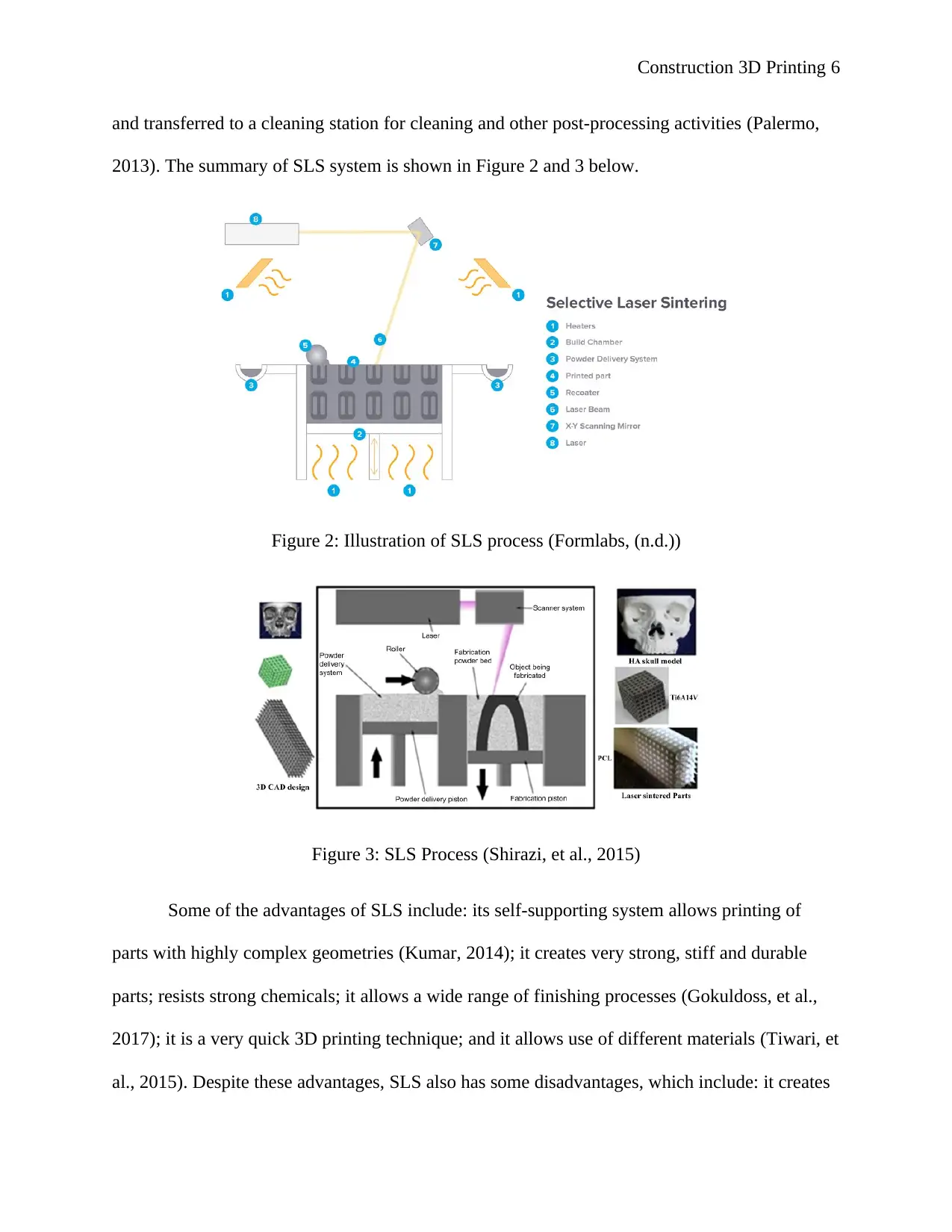
Construction 3D Printing 6
and transferred to a cleaning station for cleaning and other post-processing activities (Palermo,
2013). The summary of SLS system is shown in Figure 2 and 3 below.
Figure 2: Illustration of SLS process (Formlabs, (n.d.))
Figure 3: SLS Process (Shirazi, et al., 2015)
Some of the advantages of SLS include: its self-supporting system allows printing of
parts with highly complex geometries (Kumar, 2014); it creates very strong, stiff and durable
parts; resists strong chemicals; it allows a wide range of finishing processes (Gokuldoss, et al.,
2017); it is a very quick 3D printing technique; and it allows use of different materials (Tiwari, et
al., 2015). Despite these advantages, SLS also has some disadvantages, which include: it creates
and transferred to a cleaning station for cleaning and other post-processing activities (Palermo,
2013). The summary of SLS system is shown in Figure 2 and 3 below.
Figure 2: Illustration of SLS process (Formlabs, (n.d.))
Figure 3: SLS Process (Shirazi, et al., 2015)
Some of the advantages of SLS include: its self-supporting system allows printing of
parts with highly complex geometries (Kumar, 2014); it creates very strong, stiff and durable
parts; resists strong chemicals; it allows a wide range of finishing processes (Gokuldoss, et al.,
2017); it is a very quick 3D printing technique; and it allows use of different materials (Tiwari, et
al., 2015). Despite these advantages, SLS also has some disadvantages, which include: it creates
⊘ This is a preview!⊘
Do you want full access?
Subscribe today to unlock all pages.

Trusted by 1+ million students worldwide
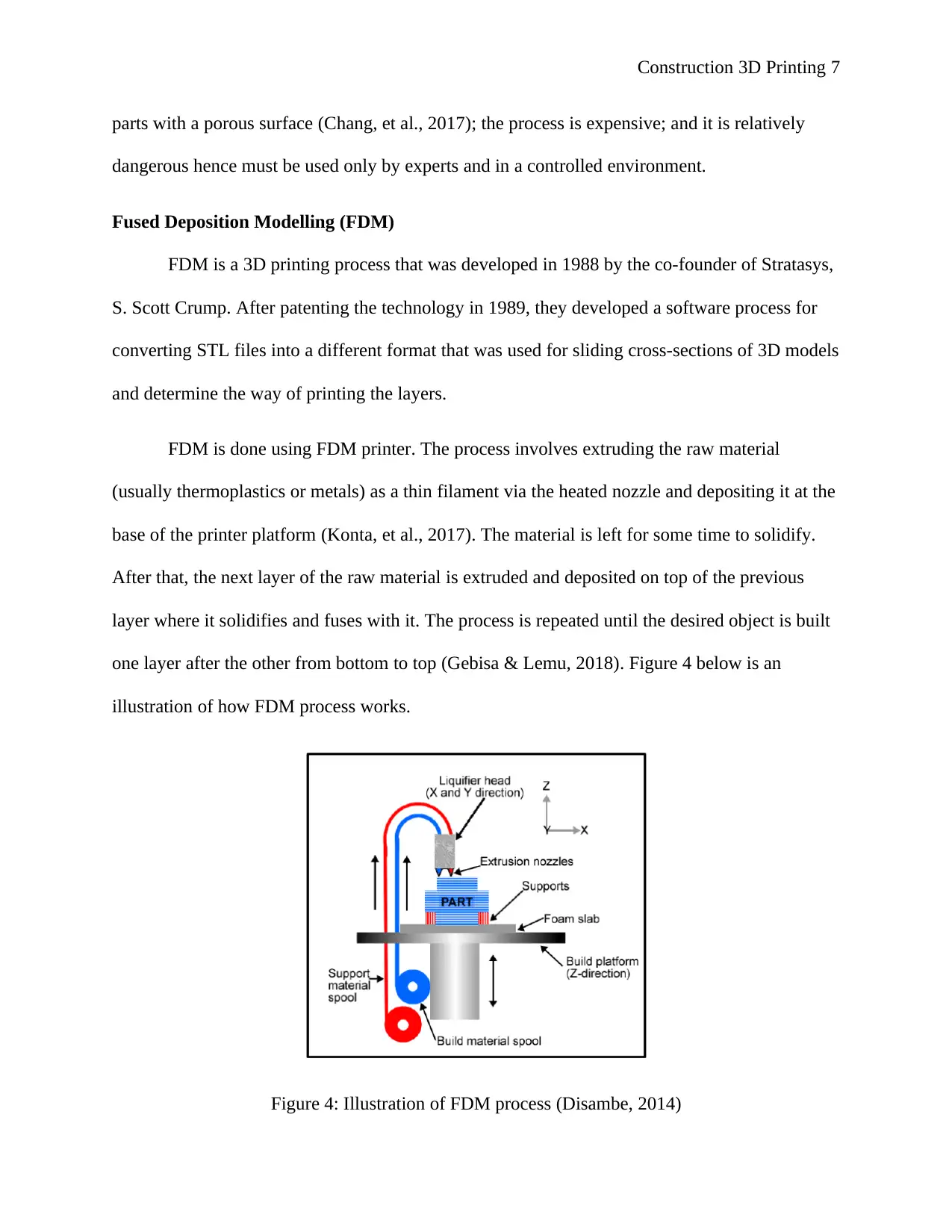
Construction 3D Printing 7
parts with a porous surface (Chang, et al., 2017); the process is expensive; and it is relatively
dangerous hence must be used only by experts and in a controlled environment.
Fused Deposition Modelling (FDM)
FDM is a 3D printing process that was developed in 1988 by the co-founder of Stratasys,
S. Scott Crump. After patenting the technology in 1989, they developed a software process for
converting STL files into a different format that was used for sliding cross-sections of 3D models
and determine the way of printing the layers.
FDM is done using FDM printer. The process involves extruding the raw material
(usually thermoplastics or metals) as a thin filament via the heated nozzle and depositing it at the
base of the printer platform (Konta, et al., 2017). The material is left for some time to solidify.
After that, the next layer of the raw material is extruded and deposited on top of the previous
layer where it solidifies and fuses with it. The process is repeated until the desired object is built
one layer after the other from bottom to top (Gebisa & Lemu, 2018). Figure 4 below is an
illustration of how FDM process works.
Figure 4: Illustration of FDM process (Disambe, 2014)
parts with a porous surface (Chang, et al., 2017); the process is expensive; and it is relatively
dangerous hence must be used only by experts and in a controlled environment.
Fused Deposition Modelling (FDM)
FDM is a 3D printing process that was developed in 1988 by the co-founder of Stratasys,
S. Scott Crump. After patenting the technology in 1989, they developed a software process for
converting STL files into a different format that was used for sliding cross-sections of 3D models
and determine the way of printing the layers.
FDM is done using FDM printer. The process involves extruding the raw material
(usually thermoplastics or metals) as a thin filament via the heated nozzle and depositing it at the
base of the printer platform (Konta, et al., 2017). The material is left for some time to solidify.
After that, the next layer of the raw material is extruded and deposited on top of the previous
layer where it solidifies and fuses with it. The process is repeated until the desired object is built
one layer after the other from bottom to top (Gebisa & Lemu, 2018). Figure 4 below is an
illustration of how FDM process works.
Figure 4: Illustration of FDM process (Disambe, 2014)
Paraphrase This Document
Need a fresh take? Get an instant paraphrase of this document with our AI Paraphraser
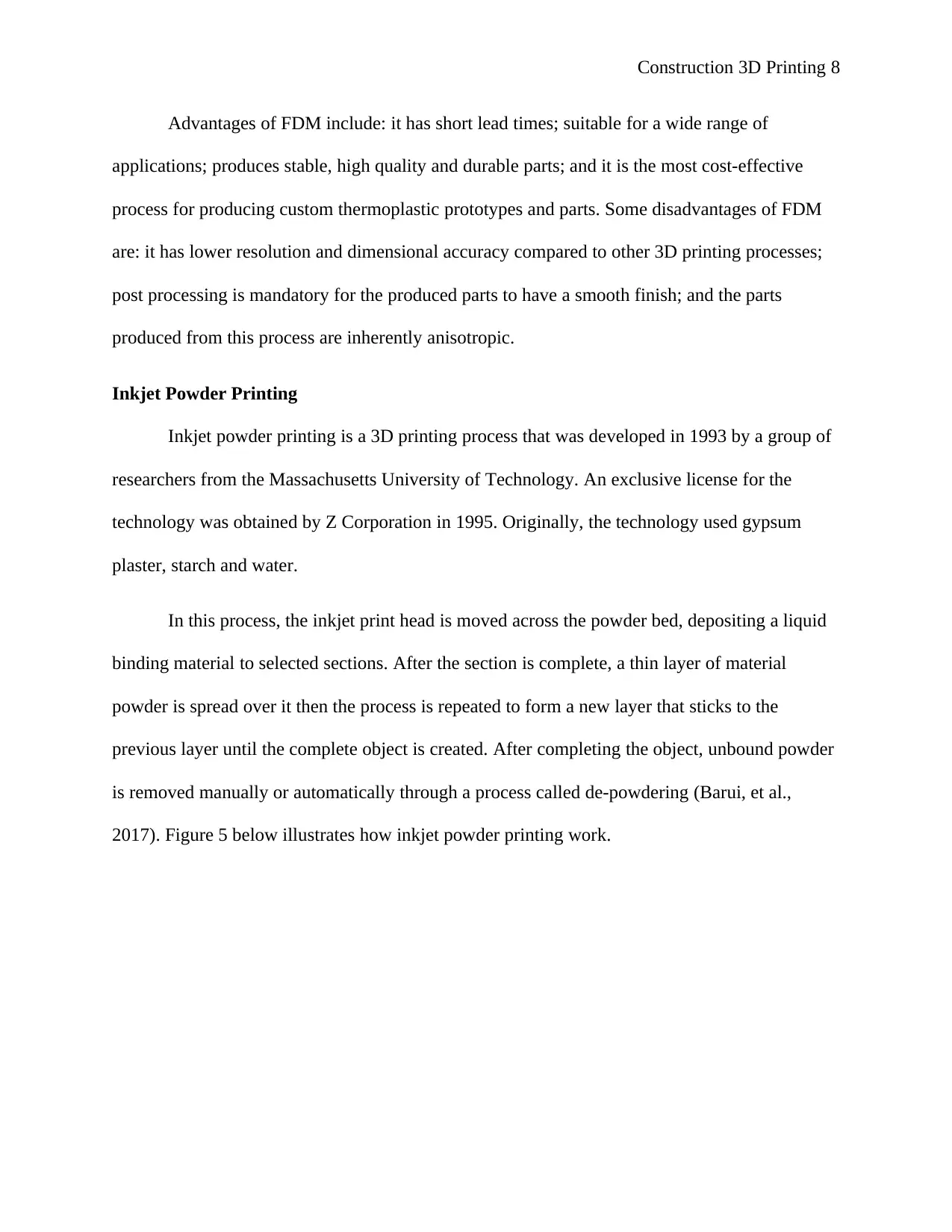
Construction 3D Printing 8
Advantages of FDM include: it has short lead times; suitable for a wide range of
applications; produces stable, high quality and durable parts; and it is the most cost-effective
process for producing custom thermoplastic prototypes and parts. Some disadvantages of FDM
are: it has lower resolution and dimensional accuracy compared to other 3D printing processes;
post processing is mandatory for the produced parts to have a smooth finish; and the parts
produced from this process are inherently anisotropic.
Inkjet Powder Printing
Inkjet powder printing is a 3D printing process that was developed in 1993 by a group of
researchers from the Massachusetts University of Technology. An exclusive license for the
technology was obtained by Z Corporation in 1995. Originally, the technology used gypsum
plaster, starch and water.
In this process, the inkjet print head is moved across the powder bed, depositing a liquid
binding material to selected sections. After the section is complete, a thin layer of material
powder is spread over it then the process is repeated to form a new layer that sticks to the
previous layer until the complete object is created. After completing the object, unbound powder
is removed manually or automatically through a process called de-powdering (Barui, et al.,
2017). Figure 5 below illustrates how inkjet powder printing work.
Advantages of FDM include: it has short lead times; suitable for a wide range of
applications; produces stable, high quality and durable parts; and it is the most cost-effective
process for producing custom thermoplastic prototypes and parts. Some disadvantages of FDM
are: it has lower resolution and dimensional accuracy compared to other 3D printing processes;
post processing is mandatory for the produced parts to have a smooth finish; and the parts
produced from this process are inherently anisotropic.
Inkjet Powder Printing
Inkjet powder printing is a 3D printing process that was developed in 1993 by a group of
researchers from the Massachusetts University of Technology. An exclusive license for the
technology was obtained by Z Corporation in 1995. Originally, the technology used gypsum
plaster, starch and water.
In this process, the inkjet print head is moved across the powder bed, depositing a liquid
binding material to selected sections. After the section is complete, a thin layer of material
powder is spread over it then the process is repeated to form a new layer that sticks to the
previous layer until the complete object is created. After completing the object, unbound powder
is removed manually or automatically through a process called de-powdering (Barui, et al.,
2017). Figure 5 below illustrates how inkjet powder printing work.
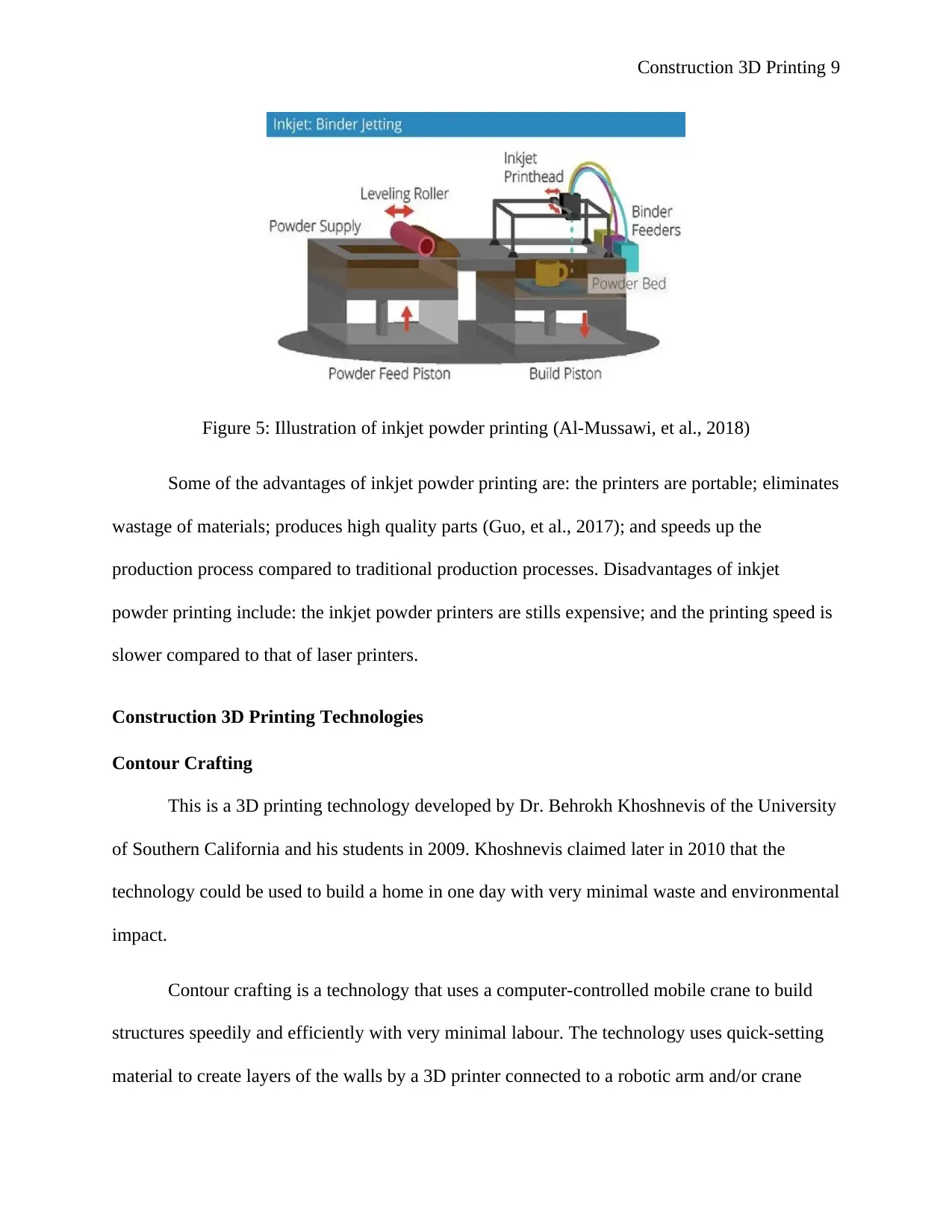
Construction 3D Printing 9
Figure 5: Illustration of inkjet powder printing (Al-Mussawi, et al., 2018)
Some of the advantages of inkjet powder printing are: the printers are portable; eliminates
wastage of materials; produces high quality parts (Guo, et al., 2017); and speeds up the
production process compared to traditional production processes. Disadvantages of inkjet
powder printing include: the inkjet powder printers are stills expensive; and the printing speed is
slower compared to that of laser printers.
Construction 3D Printing Technologies
Contour Crafting
This is a 3D printing technology developed by Dr. Behrokh Khoshnevis of the University
of Southern California and his students in 2009. Khoshnevis claimed later in 2010 that the
technology could be used to build a home in one day with very minimal waste and environmental
impact.
Contour crafting is a technology that uses a computer-controlled mobile crane to build
structures speedily and efficiently with very minimal labour. The technology uses quick-setting
material to create layers of the walls by a 3D printer connected to a robotic arm and/or crane
Figure 5: Illustration of inkjet powder printing (Al-Mussawi, et al., 2018)
Some of the advantages of inkjet powder printing are: the printers are portable; eliminates
wastage of materials; produces high quality parts (Guo, et al., 2017); and speeds up the
production process compared to traditional production processes. Disadvantages of inkjet
powder printing include: the inkjet powder printers are stills expensive; and the printing speed is
slower compared to that of laser printers.
Construction 3D Printing Technologies
Contour Crafting
This is a 3D printing technology developed by Dr. Behrokh Khoshnevis of the University
of Southern California and his students in 2009. Khoshnevis claimed later in 2010 that the
technology could be used to build a home in one day with very minimal waste and environmental
impact.
Contour crafting is a technology that uses a computer-controlled mobile crane to build
structures speedily and efficiently with very minimal labour. The technology uses quick-setting
material to create layers of the walls by a 3D printer connected to a robotic arm and/or crane
⊘ This is a preview!⊘
Do you want full access?
Subscribe today to unlock all pages.

Trusted by 1+ million students worldwide
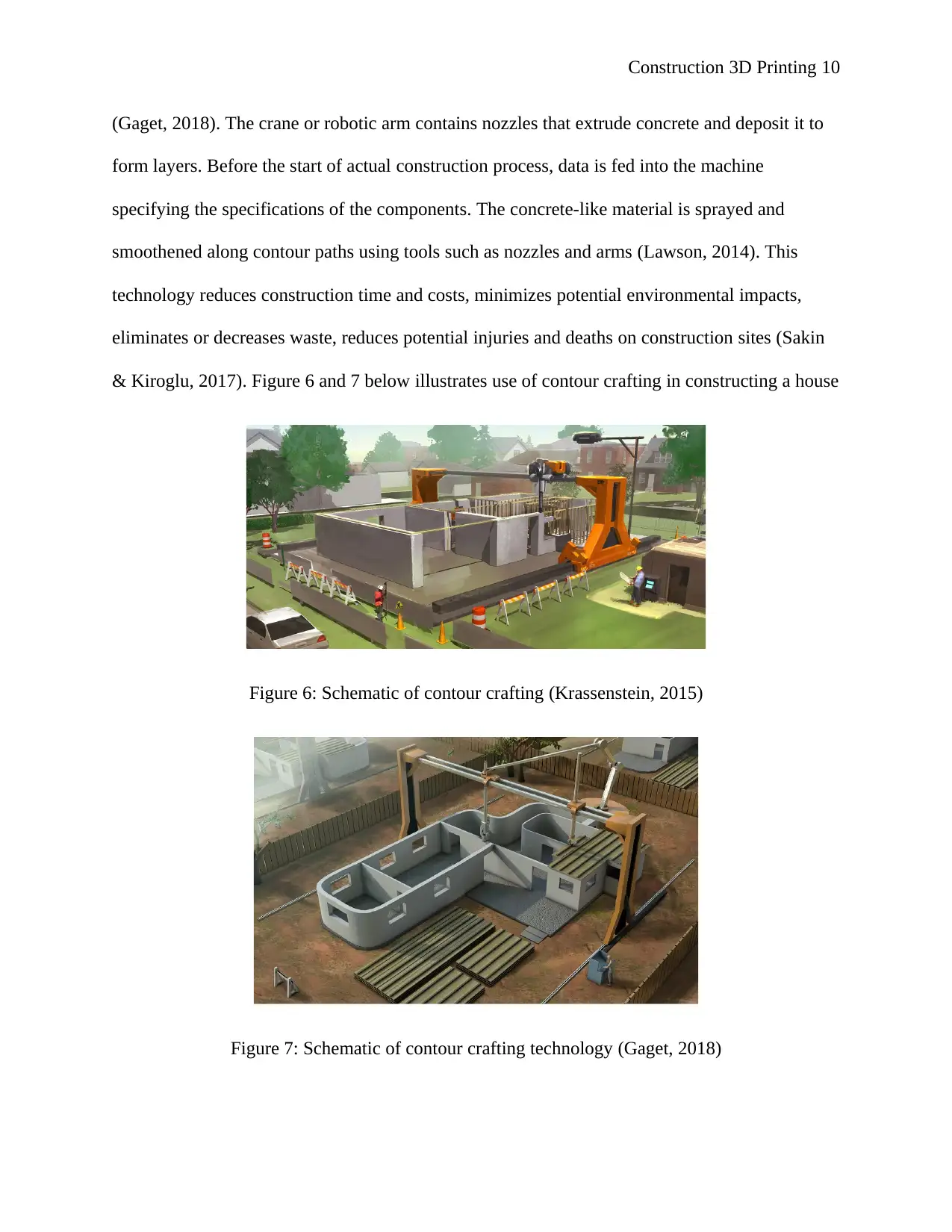
Construction 3D Printing 10
(Gaget, 2018). The crane or robotic arm contains nozzles that extrude concrete and deposit it to
form layers. Before the start of actual construction process, data is fed into the machine
specifying the specifications of the components. The concrete-like material is sprayed and
smoothened along contour paths using tools such as nozzles and arms (Lawson, 2014). This
technology reduces construction time and costs, minimizes potential environmental impacts,
eliminates or decreases waste, reduces potential injuries and deaths on construction sites (Sakin
& Kiroglu, 2017). Figure 6 and 7 below illustrates use of contour crafting in constructing a house
Figure 6: Schematic of contour crafting (Krassenstein, 2015)
Figure 7: Schematic of contour crafting technology (Gaget, 2018)
(Gaget, 2018). The crane or robotic arm contains nozzles that extrude concrete and deposit it to
form layers. Before the start of actual construction process, data is fed into the machine
specifying the specifications of the components. The concrete-like material is sprayed and
smoothened along contour paths using tools such as nozzles and arms (Lawson, 2014). This
technology reduces construction time and costs, minimizes potential environmental impacts,
eliminates or decreases waste, reduces potential injuries and deaths on construction sites (Sakin
& Kiroglu, 2017). Figure 6 and 7 below illustrates use of contour crafting in constructing a house
Figure 6: Schematic of contour crafting (Krassenstein, 2015)
Figure 7: Schematic of contour crafting technology (Gaget, 2018)
Paraphrase This Document
Need a fresh take? Get an instant paraphrase of this document with our AI Paraphraser
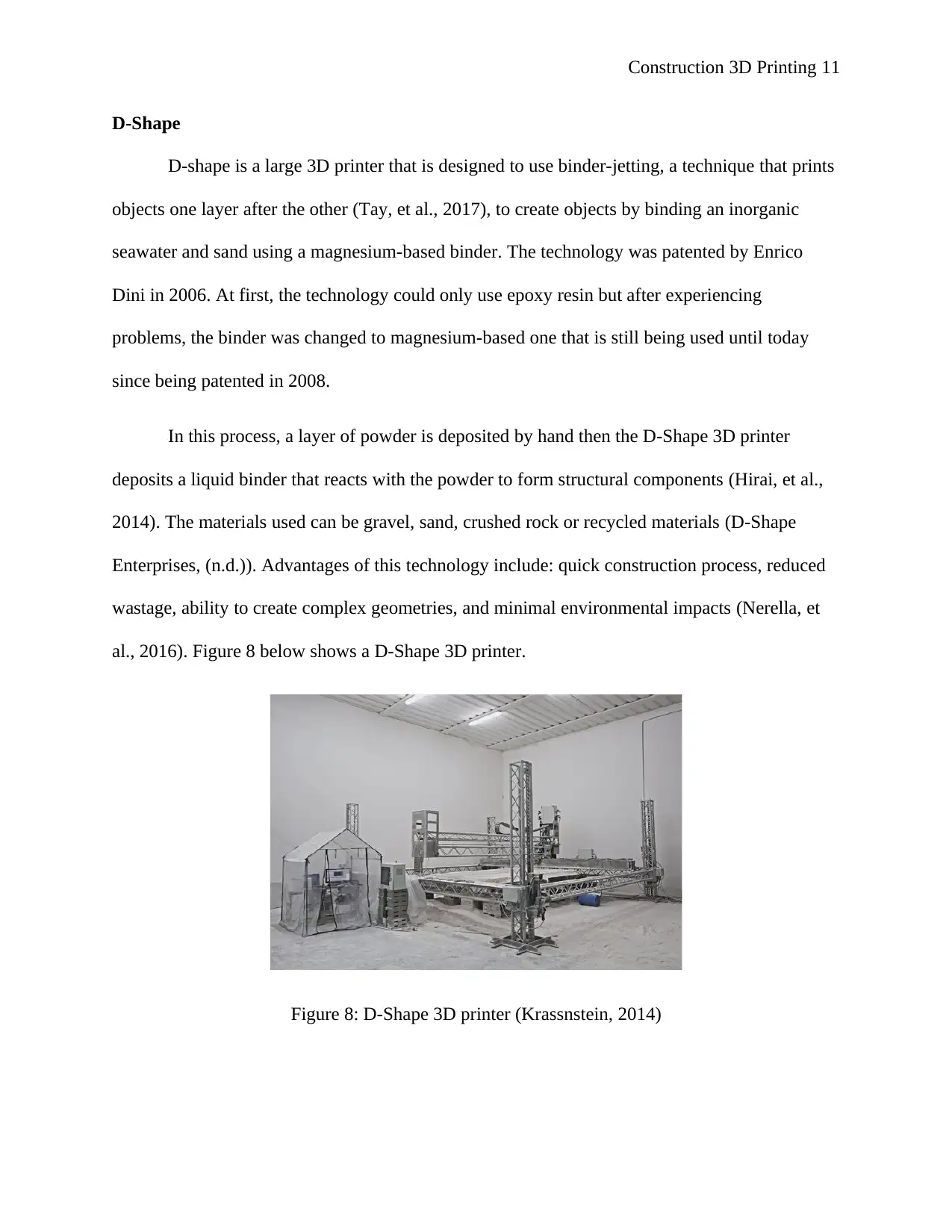
Construction 3D Printing 11
D-Shape
D-shape is a large 3D printer that is designed to use binder-jetting, a technique that prints
objects one layer after the other (Tay, et al., 2017), to create objects by binding an inorganic
seawater and sand using a magnesium-based binder. The technology was patented by Enrico
Dini in 2006. At first, the technology could only use epoxy resin but after experiencing
problems, the binder was changed to magnesium-based one that is still being used until today
since being patented in 2008.
In this process, a layer of powder is deposited by hand then the D-Shape 3D printer
deposits a liquid binder that reacts with the powder to form structural components (Hirai, et al.,
2014). The materials used can be gravel, sand, crushed rock or recycled materials (D-Shape
Enterprises, (n.d.)). Advantages of this technology include: quick construction process, reduced
wastage, ability to create complex geometries, and minimal environmental impacts (Nerella, et
al., 2016). Figure 8 below shows a D-Shape 3D printer.
Figure 8: D-Shape 3D printer (Krassnstein, 2014)
D-Shape
D-shape is a large 3D printer that is designed to use binder-jetting, a technique that prints
objects one layer after the other (Tay, et al., 2017), to create objects by binding an inorganic
seawater and sand using a magnesium-based binder. The technology was patented by Enrico
Dini in 2006. At first, the technology could only use epoxy resin but after experiencing
problems, the binder was changed to magnesium-based one that is still being used until today
since being patented in 2008.
In this process, a layer of powder is deposited by hand then the D-Shape 3D printer
deposits a liquid binder that reacts with the powder to form structural components (Hirai, et al.,
2014). The materials used can be gravel, sand, crushed rock or recycled materials (D-Shape
Enterprises, (n.d.)). Advantages of this technology include: quick construction process, reduced
wastage, ability to create complex geometries, and minimal environmental impacts (Nerella, et
al., 2016). Figure 8 below shows a D-Shape 3D printer.
Figure 8: D-Shape 3D printer (Krassnstein, 2014)
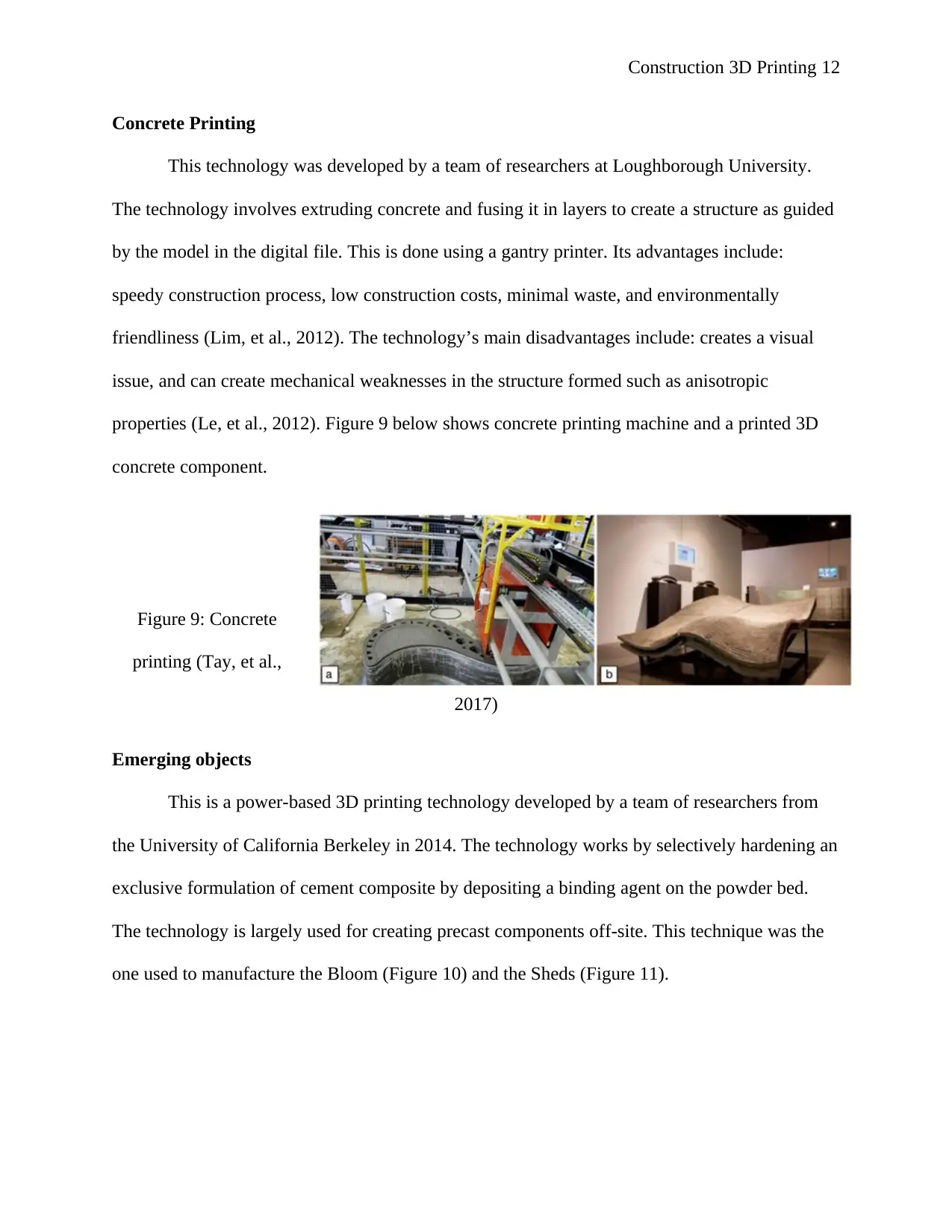
Construction 3D Printing 12
Concrete Printing
This technology was developed by a team of researchers at Loughborough University.
The technology involves extruding concrete and fusing it in layers to create a structure as guided
by the model in the digital file. This is done using a gantry printer. Its advantages include:
speedy construction process, low construction costs, minimal waste, and environmentally
friendliness (Lim, et al., 2012). The technology’s main disadvantages include: creates a visual
issue, and can create mechanical weaknesses in the structure formed such as anisotropic
properties (Le, et al., 2012). Figure 9 below shows concrete printing machine and a printed 3D
concrete component.
Figure 9: Concrete
printing (Tay, et al.,
2017)
Emerging objects
This is a power-based 3D printing technology developed by a team of researchers from
the University of California Berkeley in 2014. The technology works by selectively hardening an
exclusive formulation of cement composite by depositing a binding agent on the powder bed.
The technology is largely used for creating precast components off-site. This technique was the
one used to manufacture the Bloom (Figure 10) and the Sheds (Figure 11).
Concrete Printing
This technology was developed by a team of researchers at Loughborough University.
The technology involves extruding concrete and fusing it in layers to create a structure as guided
by the model in the digital file. This is done using a gantry printer. Its advantages include:
speedy construction process, low construction costs, minimal waste, and environmentally
friendliness (Lim, et al., 2012). The technology’s main disadvantages include: creates a visual
issue, and can create mechanical weaknesses in the structure formed such as anisotropic
properties (Le, et al., 2012). Figure 9 below shows concrete printing machine and a printed 3D
concrete component.
Figure 9: Concrete
printing (Tay, et al.,
2017)
Emerging objects
This is a power-based 3D printing technology developed by a team of researchers from
the University of California Berkeley in 2014. The technology works by selectively hardening an
exclusive formulation of cement composite by depositing a binding agent on the powder bed.
The technology is largely used for creating precast components off-site. This technique was the
one used to manufacture the Bloom (Figure 10) and the Sheds (Figure 11).
⊘ This is a preview!⊘
Do you want full access?
Subscribe today to unlock all pages.

Trusted by 1+ million students worldwide
1 out of 24
Related Documents
Your All-in-One AI-Powered Toolkit for Academic Success.
+13062052269
info@desklib.com
Available 24*7 on WhatsApp / Email
![[object Object]](/_next/static/media/star-bottom.7253800d.svg)
Unlock your academic potential
Copyright © 2020–2025 A2Z Services. All Rights Reserved. Developed and managed by ZUCOL.





